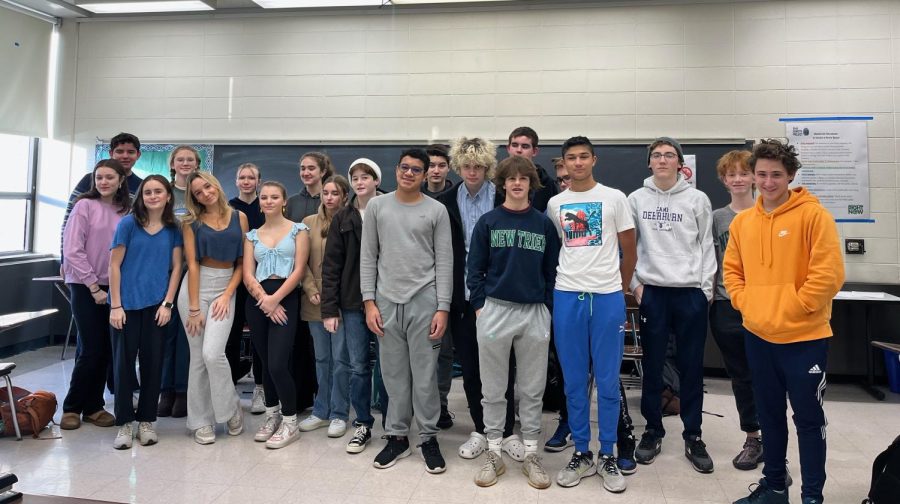New mixed gender adviseries offer students new opportunities
New mixed advisery better fit for some teachers, advisers
Weber
The Wysocki advisery is one of 13 new mixed gender adviseries at the Northfield Campus this year
This fall, after 93 years, the school implemented its first ever mixed gender advisery for incoming freshmen. Now there are 7 mixed gender adviseries, 7 single male adviseries and 7 single female adviseries for the freshman class.
The feedback so far has been overwhelmingly positive.
Freshmen Matthew Miralles and Noah Husain both chose “no preference” when they selected their advisery last January. Both were placed into mixed gender adviseries.
“I think the choice will grow, and more and more people will select [mixed gender] until [single gender] maybe becomes archaic.”
Husain said he would like to see students continue to have this option in the future.
Miralles, though happy with his decision, feels more of a divide from the single gender advisery. Many of his middle school companions ended up in the same single gender advisery.
“All my other friends have a lot of friends in their advisery,” he said. “I don’t feel that same connection.”
Miralles said he supports the continuation of this system and would even support a fully mixed gender advisery program. He said it could help to remove that divide.
For many, the transition to this new system has proved to be smooth. Freshman mixed gender adviser Leslie Skizas feels the connections between students haven’t decreased with this change.
“Immediately I noticed the benefits,” said Skizas. “We still have the same conversations and same energy as I had in my single advisery.”
Freshman Girls Adviser Chair Susan Haak said the connections between students can differ from student to student and room to room.
“Every year there are always scenarios where freshmen don’t connect in the adviser rooms,” she said. “We are still having those conversations and trying to connect students. But the question this year is, we wonder if that’s normal or if it is due to the new structure.”
Administrators are impressed with the fluidity of this transition due to the flexibility of advisers and senior helpers who attend twice a week.
Like the class of 2026, freshman advisers were given the choice of teaching a mixed gender or single gender advisery for this school year.
“In the spring we were given the same choice as the freshman,” Skizas said. “It was either single, mixed or no preference.”
The decision to create mixed gender adviseries was made unanimously by the board of education on November 15, 2021.
The process leading up to this decision, however, has been in the works for many years.
Haak said the dedication to making this process happen was immense.
“We talked about it with all the adviser chairs, advisers, administration, and more,” she said. “It was a pretty big group.”
The advisery program has always been unique in that it extends beyond a study hall or homeroom period. It offers an environment where students can make friends and receive guidance for academic and social issues. It is a safe space where students can return every morning.
The single gender advisery system did not serve the needs of all students, and sometimes left students feeling out of place or uncomfortable. The change aims to serve the needs of all students, and ensure each and every student has a safe community to feel included.
According to the adviser board presentation regarding the decision 48%, of the 774 surveyed, said they would prefer a mixed gender advisery. 52% said they would prefer a single gender advisery.
The survey also revealed that LGBTQ+ students – specifically students who are transgender or identified as nonbinary or gender nonconforming – felt uncomfortable in the single gender advisery system.
In the annual course selection period in late January, the incoming class of 2026 was given a new choice for advisery: single, mixed, or no preference. The no preference option was put in place for those who did not wish to make this decision, as some wanted to be randomly placed.
Haak said administrators worried they “wouldn’t have enough for each grouping,” but with the no preference option, they were able to “fill the gaps.”
Both advisers and administrators remain unsure of how exactly this will look in the future – whether it will remain an option for students or all adviseries will transition to co-ed.
“If I had to guess, we would continue to offer it as a choice,” Skizas said. “But I think the choice will grow, and more and more people will select [mixed gender] until [single gender] maybe becomes archaic.”
Haak said it is too early to tell the future of this new system.
“We are excited to see how it progresses over four years,” she said. “Because we know the adviser experience takes a while to develop.”








































